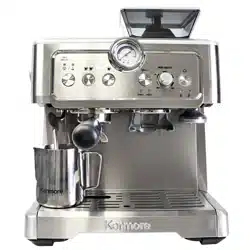Loading ...
Loading ...
Loading ...

GETTING THE MOST OUT OF YOUR MACHINE
TROUBLESHOOTING
24
25
Espresso flowing too
quickly; espresso
tastes sour and watery
Espresso flowing too
slowly or stopping
early; espresso tastes
bitter and dark
No crema
No ground coffee
from grinder
Grind size too coarse
Tamp too light
Filter basket underfilled
Coffee beans too old and dry
Grind size too fine
Tamp too firm
Filter basket overfilled
Grouphead or filter clogged
with coffee residue
Water tank empty or not
positioned correctly
Water line clogged with coffee
residue or scale
Coffee beans too old and dry
Grind size too coarse
Tamp too light
Filter basket partly blocked
Bean hopper empty
Blockage in grinder
Moisture in grinder
Empty filter and retry with a finer
grind
Empty filter and retry with a
harder tamp
Empty filter and retry with more
coffee
Empty filter and retry with fresh
beans
Empty filter and retry with a
coarser grind
Empty filter and retry with a
lighter tamp
Empty filter and retry with less
coffee
Purge grouphead
Clean shower screen and filter
holes with a brush or pin
Refill water tank
Reposition water tank
Flush the system and retry
Run a descaling cycle and retry
Empty filter and retry with fresh
beans
Empty filter and retry with a finer
grind
Empty filter and retry with a
harder tamp
Clean filter holes with a brush or
pin and retry
Fill hopper with fresh coffee
beans
Turn grind size selector 2-3 steps
in either direction and grind for a
few seconds
Remove hopper and brush away
any debris from burrs and grind
outlet
Remove hopper and dry with a
clean cloth
CHOOSING YOUR BEANS
• Look at and smell your beans: The ideal espresso beans will have an intense, almost nutty or
chocolatey scent and will look shiny but not overly oily or greasy.
• Whenever possible, use whole coffee beans ground immediately before brewing.
• Coffee beans are at their peak flavor 5-10 after roasting, so check the bag for a "Roasted On" date
rather than "Best Before" or "Use By" and don't buy more than you can use.
• Store your beans in an airtight container in a cool, dark place but don't freeze them! Freezing
creates hairline fractures that make your beans go stale faster and can expose them to unwel-
come flavors and aromas from other stored foods.
EXTRACTING ESPRESSO
• Preheat your espresso cups by placing them on the warming tray on top of the machine until
you are ready to use them.
• A cold portafilter and filter basket can affect the extraction temperature and impact the quality
of your espresso. Preheat your filter basket and portafilter by rinsing them with hot water and
wipe dry with a clean cloth before dosing.
• When experimenting with grind size, dose, tamp, and volume to achieve your ideal espresso
shot, adjust one factor at a time so you know which changes were effective.
• Extract at least 2 shots of espresso to check the results before making another change.
TEXTURING MILK
• The fresher and colder the milk is, the better it will froth. Whenever possible, chill your milk
pitcher before using and use milk cold from the fridge.
• To avoid splattering hot milk, keep the steam wand tip completely submerged until you have
turned the steam completely off.
• The milk's temperature will rise by about another 5 degrees after you stop steaming. If using a
thermometer, stop when it reaches 140-149°F or 60-65°C to avoid overheating.
• You can also monitor the temperature with one hand on the bottom of the pitcher and stop
when it is hot to touch, but be extremely careful not to burn yourself.
• Fat content matters:
• Low fat milk froths easily and produces a stable, voluminous foam with a dry mouthfeel. When
making a cappuccino with lower fat milk, it's important to work quickly before the foam and
liquid start to separate.
• Higher fat milk (2% fat or greater) takes longer to froth and produces a smaller volume of foam
with a rich, velvety taste and wet mouthfeel. This creamy microfoam mixes readily with the liquid
milk and stays combined longer, making it easier for beginners to work with.
• You can make delicious lattes and cappuccinos with some, but not all, plant-based milks:
• Best for steaming and foaming: Oat, almond, soy, or coconut milk.
• Good for steaming but produce little to no foam: Hemp, rice, and cashew milk.
PROBLEM POSSIBLE CAUSE POSSIBLE SOLUTION
Loading ...
Loading ...
Loading ...
